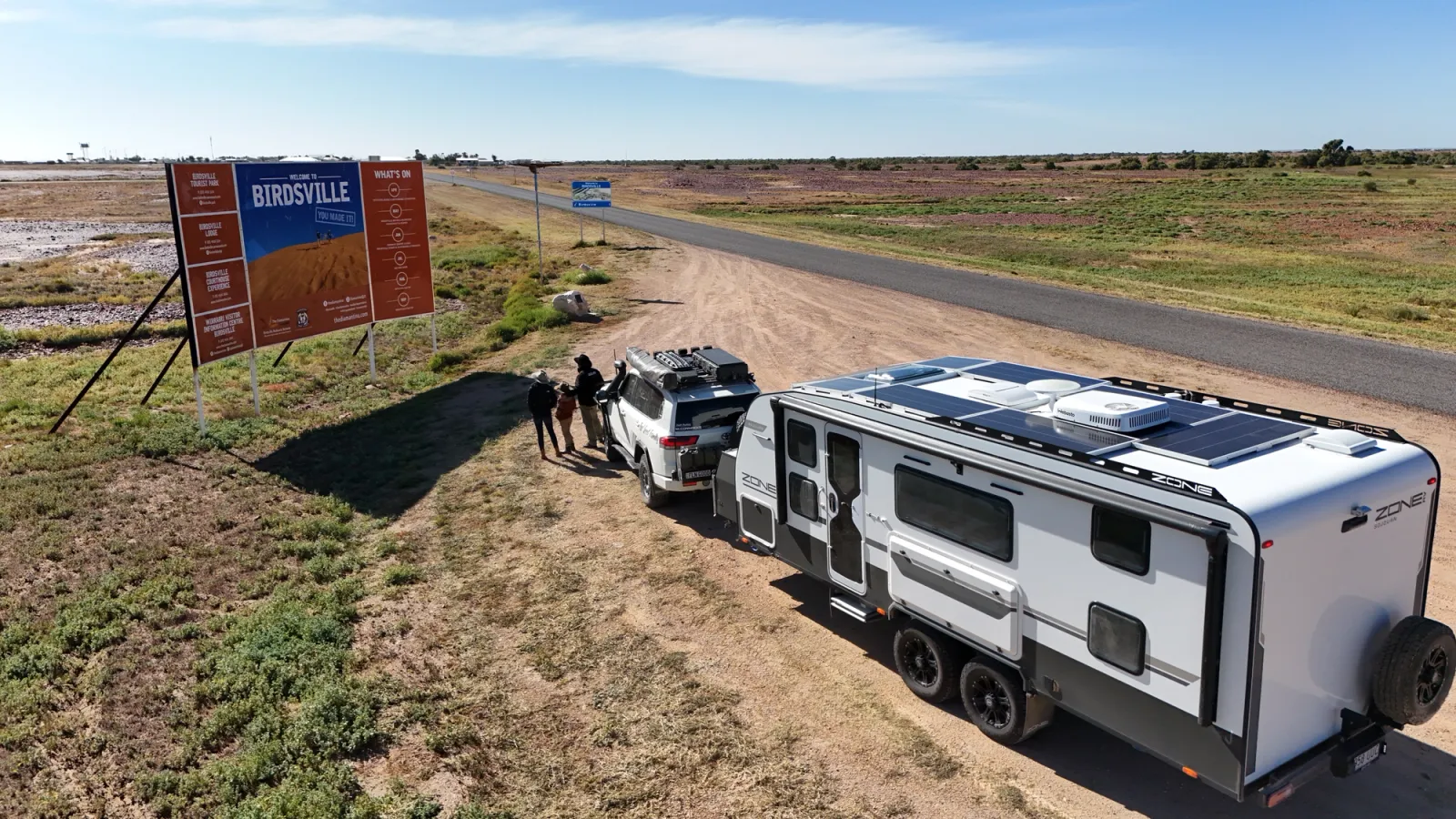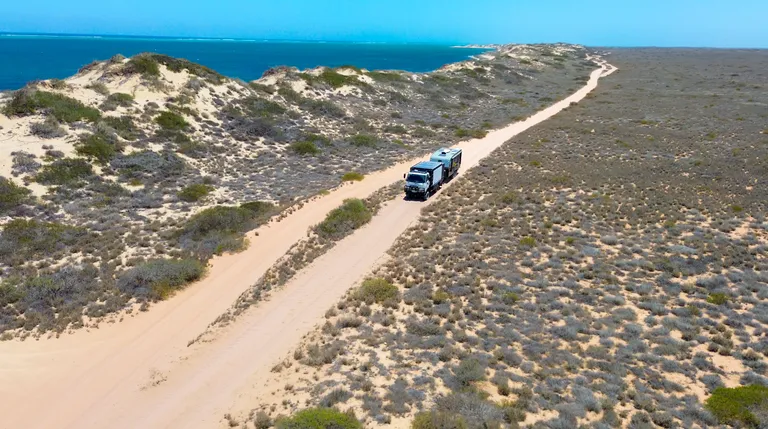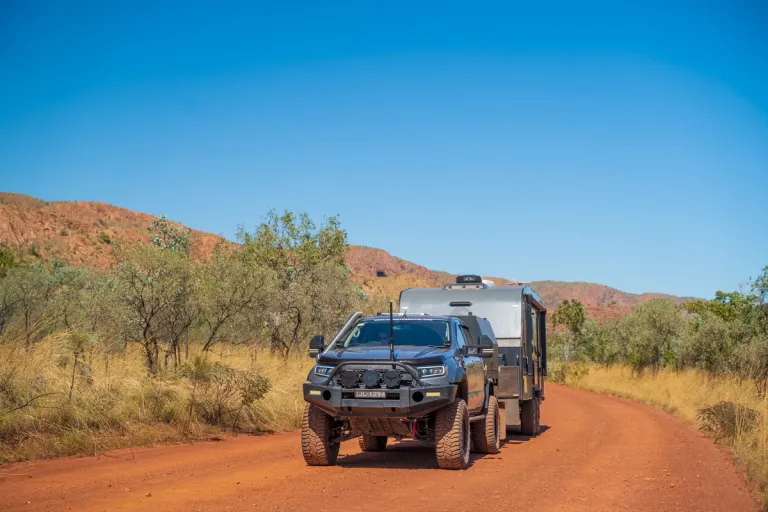There’s something magical about leaving the bitumen behind. The road narrows, the crunch of the tyres changes, and suddenly you’re in the realm of dust, corrugations, and big, endless skies. It’s where the real adventure begins, but it’s also where preparation makes all the difference.
On our recent trip from South East Queensland to Birdsville for the Big Red Sunset Concert, we clocked up hundreds of kilometres on dirt, gravel, and sandy tracks. Some were as smooth as a country backroad, while others—like the stretch between Windorah and Birdsville—were the rockiest roads we’ve ever experienced, notorious for damaging fourbies and testing even the most prepared travellers.
Whether you’re planning your first dirt road detour or a full-blown desert crossing, these tips will help keep you, your vehicle, and your gear safe—and your adventure unforgettable.
1. Tyre Pressure: Your First Line of Defence
If there’s one thing that can make or break your off-road experience, it’s tyre pressure. Without the right pressures, it’s the perfect recipe for cracked rims, shredded tyres, and an unpleasant ride.
Why it matters: Lowering your tyre pressure increases the surface area of the tyre on the track, giving you better grip and cushioning the impact of rocks, ruts, and corrugations. It’s not just about comfort, it’s about safety and tyre longevity.
Our rule of thumb:
- Gravel and corrugations: We drop to around 28-32 PSI
- Sand: We drop our pressure further, 18-22 PSI is often the sweet spot for traction.
- Back to bitumen: Don’t forget to reinflate before hitting the highway. Soft tyres on sealed roads can overheat the sidewalls and fail.
* Always follow vehicle and tyre manufacturers guidelines and do your own research relevant to your vehicle and set-up.
We always travel with a quality tyre pressure gauge, tyre deflators and an air compressor on board. When you’re hundreds of kilometres from help, having reliable, easy-to-use gear can be the difference between a quick adjustment and a long wait on the side of the track. Investing in quality gear from the start is one of the smartest decisions you can make for off-road travel.
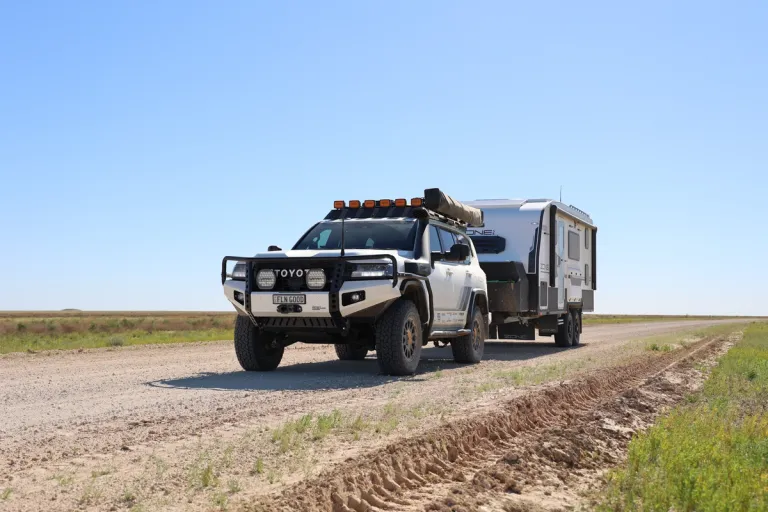
4x4 towing caravan on dirt road with blue sky
2. Gear Check: Prepare Before You Need It
When you’re travelling remote, even a small gear failure can cut your trip short. Before heading off the bitumen towards Birdsville, we did a full pre-trip check and vehicle service.
Key checks before you roll:
- Tyres & spares: Inspect tread, sidewalls, and make sure your spare (or spares) are balanced and in good nick.
- Recovery gear: Snatch straps, soft shackles, recovery boards, and a rated recovery point on your vehicle.
- Tools: Enough to tackle basic repairs—socket set, tyre repair kit, spare fuses, filters, and fluids.
- Communication: UHF radio for convoy and local chatter, and we always carry a Personal Locator Beacon (PLB) for remote emergencies.
- First aid: A fully stocked kit tailored for remote travel, including snake bite bandages.
Out here, self-reliance (and the ability to help others) is part of the code. The more prepared you are, the more capable you’ll be if something goes wrong. Whether that’s fixing your own issue or lending a hand to a fellow traveller, carrying the right gear, knowing how to use it, and keeping it in good condition means you can handle most challenges the outback throws your way.
3. Route Planning: Know What’s Ahead
Good route planning is essential for safe and enjoyable off-road travel. Before you leave the bitumen, take the time to research where you’re going, the current conditions, and the services available along the way. This helps you avoid unnecessary risks, ensures you have enough fuel, food, and water for the journey, and allows you to adjust plans if the weather or track conditions change.
Good route planning means:
- Researching road conditions: Local councils, visitor centres, and apps like QLD Traffic or ExplorOz Traveller are gold for up-to-date info.
- Factoring in fuel stops: Between Windorah and Birdsville there’s not much in the way of bowsers. Carry extra if your range is borderline, and if possible we always fill when the dial hits halfway.
- Knowing your limits: Some tracks look tempting but can be brutal after rain. Always have a Plan B.
On this trip, recent rain had transformed parts of the outback into a surprisingly green landscape - beautiful, but also extremely muddy in sections. Planning meant we knew where the trouble spots were likely to be, and we could adjust our pace and plans accordingly.
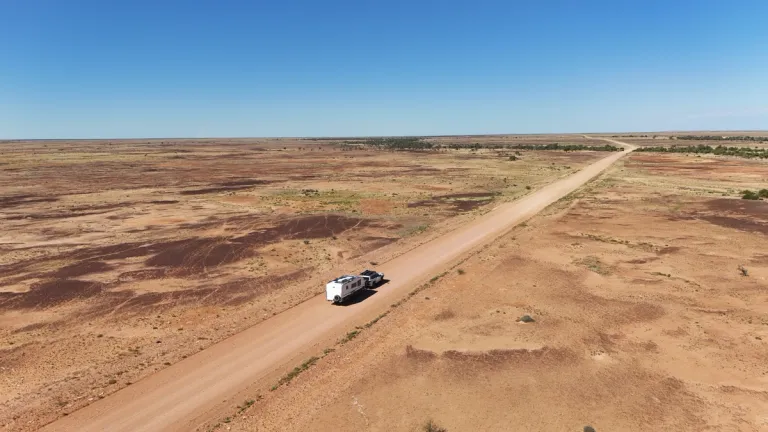
4x4 towing caravan through outback aerial shot
4. Drive to Conditions - Not the Speed Limit
Out here, there’s no prize for getting there first. On the way to the Big Red Sunset Concert, we saw rigs pushing way too hard over corrugations and extremely rocky roads. You can almost hear the suspension groaning and the risk related to speed is unnecessary.
The key? Read the road. Slow down for dips, bulldust patches, and creek crossings. Don’t straddle deep ruts unless you’re sure you’ve got the clearance. On gravel, ease into corners rather than braking hard - that’s a shortcut to losing control.
When overtaking or passing oncoming traffic, think about the conditions you’re creating for others. On dusty roads, wait until you have clear visibility before moving out, and on rocky stretches, slow right down to minimise the risk of flicking up stones that could chip or crack windscreens. A little courtesy goes a long way in the outback.
We keep our UHF tuned to Channel 40 for road trains. Out here, they own the road, and giving them plenty of room is just good manners (and self-preservation).
5. Respect Your Payload and Towing Setup
Off-road travel puts extra strain on every part of your vehicle and caravan. Overloading is a fast track to broken suspension, tyre blowouts, and insurance headaches. Before heading off-road, it’s important to know your vehicle and van weights—your Gross Vehicle Mass (GVM), Gross Combination Mass (GCM), and Tow Ball Mass/Weight (TBM or TBW)—and make sure you’re operating within legal and safe limits. Proper weight distribution across your setup will also help maintain stability and handling.
On corrugated roads, finding the “sweet spot” in speed is key. Too slow, and you’ll feel every bump; too fast, and you risk losing control or damaging your rig. Aim for a speed that allows your vehicle to skim over the corrugations while still maintaining safe handling, braking ability, and control.
Inside your van, secure everything as best you can. We’ve seen corrugations work their way through cupboards and fridges in ways you wouldn’t believe! Even jars in the fridge can end up upside down, or have their lids worked loose entirely, just from the vibration.
6. Be Self-Sufficient, But Flexible
One of the golden rules of remote off-road travel is to carry more than you think you’ll need in fuel, water, and food. Birdsville might have a pub and a bakery, but if you’re stuck hundreds of kilometres out with a road closed, you’ll be grateful for those extra supplies.
When stocking up for remote travel, be conscious of how much weight you’re adding and where you’re storing it. Fuel, water, and tinned food are heavy, so keep them low and central (over the axles is ideal) to maintain stability and stay within your weight limits.
At the same time, be flexible. Weather, road closures, or even a spontaneous sunset at Big Red might change your plans. On this trip, we stayed an extra night free camping on the Birdsville Common just to soak it all in, swapping stories with fellow travellers and topping up our tanks at the town’s free drinking water taps.

4x4 towing caravan in outback with road sign and road conditions
Final Thoughts
Leaving the bitumen is where Australia really opens up. From the ochre dunes of the Simpson Desert to the endless gibber plains, it’s where the adventure lives. But it’s also where preparation, respect for the conditions, and the right gear make the difference between a story you’ll tell for years, and a cautionary tale.
Our run to Birdsville reminded us why we love off-road travel so much. The sense of freedom; the camaraderie of the road; the satisfaction of tackling the terrain and arriving safe, ready for whatever’s next.
So, before you head for that dusty horizon, check your gear, drop your pressures, plan your route, and remember, the journey is as much the reward as the destination.
Safe travels, and we’ll see you out there.
Planning your next off-road adventure?
Anywhere you can legally go in Australia, we'll be in tow.


